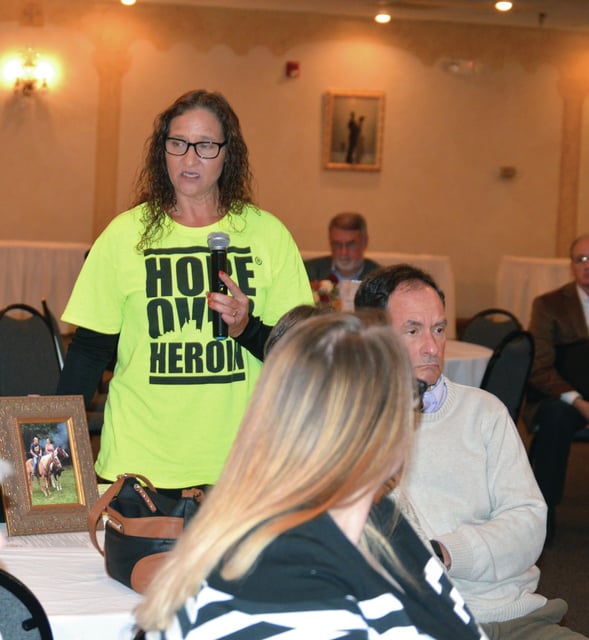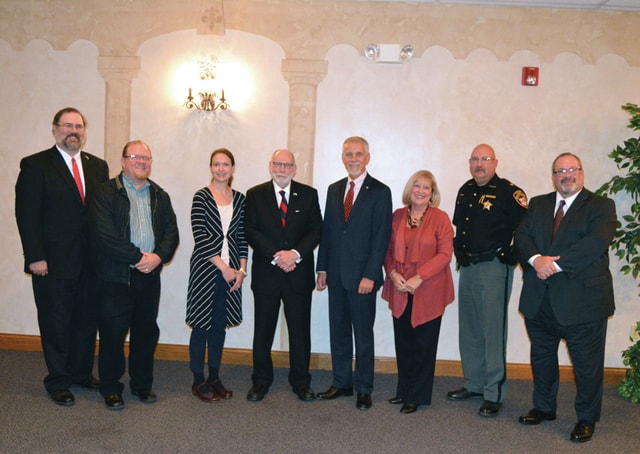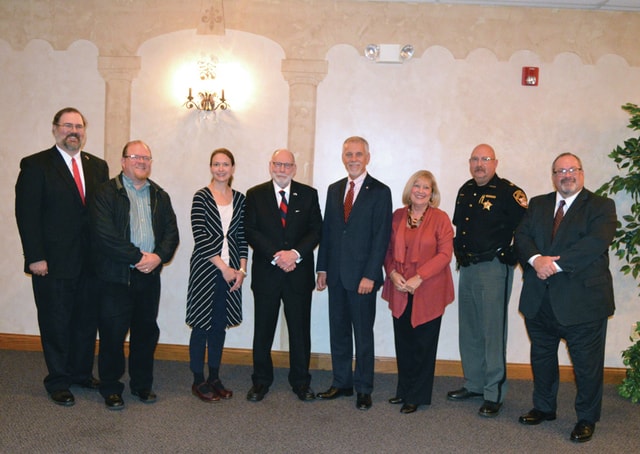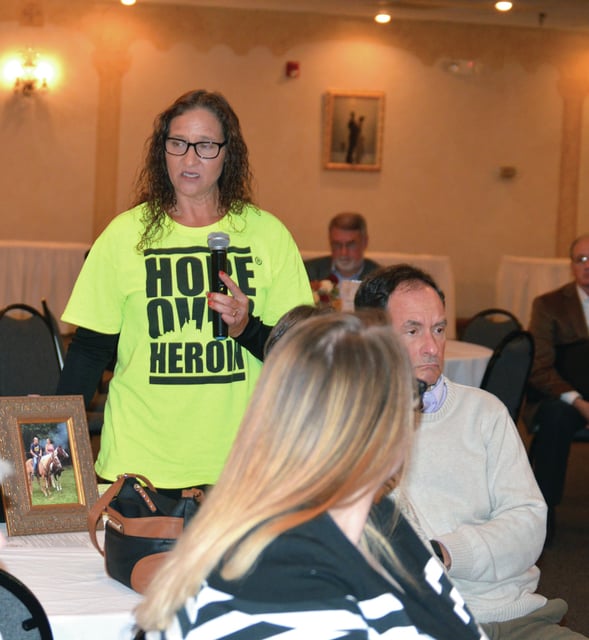









GREENVILLE — The Coalition for a Healthy Darke County held its first public meeting, a “Community Conversation on Heroin” to engage the community on the topic of heroin and what’s been happening in the county as the number of users and addicts continue to rise.
“Heroin’s grip has been felt in every community in Ohio and mirroring the national trend, heroin use in Darke County is on the rise,” said Sharon Deschambeau, president of the Coalition for a Healthy Darke County.
A group of panelists educated attendees on what was happening in their realm of expertise individually and as part of a system to help those drug addicted. The panel included Anna Hatic, D.O, Board Certified Internal Medicine, Family Health; Mark McDaniel, Executive Director, Tri-County Board of Recovery and Mental Health Services; Judge Jonathan Hein, Darke County Common Pleas Court; Chief Deputy Mark Whittaker, Darke County Sheriff’s Office; Pastor Peter Menke, St. Paul Evangelical Lutheran Church; and Pastor Mark Burd, The First Heavy Metal Church of Christ.
McDaniel spoke of opioid overdose data on the national and state levels.
According to the Department of Health and Human Services, from 2011-2014, data was tracked for heroin overdoses and opioid analgesics (painkillers) overdoses. In 2011, there were 4,397 heroin overdose deaths in the U.S. In 2014, the number more than doubled to 10, 574. Between 2011-2013, the number of opioid analgesics overdose deaths stayed about flat. Those years saw about 16,000 deaths. In 2014, the number jumped to 18,893 deaths.
The total numbers of drug-related deaths shows a very steady climb, said McDaniel. The total number of deaths in 2014 was 47,055 people.
“In many of the statistical categories Ohio is a top state in a variety of different types of overdoses,” said McDaniel. “Ohio is the center point for a lot of these issues.”
Opioid deaths grew from 2013-2015 from 2,347 to 3,050. According to the Ohio Department of Health, the factor driving the increased deaths has been the drug fetanyl, a potent opioid pain medication, and its use in combination with heroin.
McDaniel said there has been strong efforts in Ohio to combat how people are getting medications through the Ohio Automated RX Reporting System (OARRS), a data base that pharmacists use to check that people aren’t “doctor surfing” to get multiple prescriptions filled for pain killers.
McDaniel said there were a number of treatment options available for opioid addicts including life skills training, Recovery & Wellness programs, narcan (medication that blocks the effects of opioids and reverses an overdose) availability to first responders, community-based prevention strategies, medication take back events, medication assisted treatment (vivitrol, suboxone, methadone), residential and outpatient detox centers and community support systems.
Chief Deputy Mark Whittaker spoke to how opioid addiction and substance abuse has had an impact on law enforcement.
“Unfortunately, law enforcement,…first responders and EMS…are dealing with this daily,” said Whittaker.
Whittaker, a Darke County native, has 20 years of service at the Sheriff’s Office, he was a paramedic before that, totaling 30 years in public safety. Over the years, he said he’s watched drugs infiltrate into the community.
“I never thought as a paramedic I would have to treat a mother of a star basketball player in a local school district whose laying there overdosed in her bathroom,” shared Whittaker. “I never thought that day would come, but it did…That was an isolated event a number of years ago and now it’s almost a daily occurrence.”
Whittaker said the resources it takes to manage drug abuse in the community is significant and overwhelming.
“We can’t arrest ourselves out it, and that’s not the answer. Throwing substance abusers and addicts in jail is not going to solve the problem,” said Whittaker.
Law enforcement chooses to focus on the drug traffickers, said Whittaker. In Darke County most of the drug dealers are also substance abusers and are dealing to support their addiction, he explained. Most of the drugs are brought in from Dayton.
Whittaker explained the proactive approach for the department is drug interdiction of people moving drugs on State Route 49, the use of a K-9 unit and drug officers. Associated crimes come with addiction like theft, robbery, child abuse and child neglect.
Accidental overdose deaths (does not include suicides) in Darke County has steadily increased since 1995-1996 when three deaths per year was average; 2005-2006 there was an increase to 10 deaths due to prescription medications; in 2014-2015 there were 10 deaths (heroin, fentanyl) and in 2016, so far, there have been 17 deaths. Other drug-related statistics that are increasing and not tracked regularly are those that include traffic fatalities, narcan-treated patients at the hospital or by EMS, or those who are saved physically from narcan but suffer brain injury and are placed in long-term care facilities.
Whittaker reported that the age of drug abuse has declined, now reaching high-school teenagers.
“We had older people using drugs, in their 40s, 50s, 30s. The youngest death we have is 22…and now our drug officers are interacting with 17 year olds…who are introducing heroin to our high school students,” said Whittaker.
Judge Hein explained that in his 32 years of service there’s always been a social issue with some sort of drug, however the consequences of heroin are more significant.
“Five years ago, even though there’s always been a ‘drug of the day,’ the state decided to change how we would deal with the ‘drug of the day.” Before heroin was attacking us, the state changed their philosophy, House Bill 86…to not try to punish, incarcerate or imprison our way to sobriety,” explained Hein.
H.B. 86 in 2011 emphasized rehabilitation and training, he said. The bill applies to low-level, substance abusers.
“So what the emphasis has been for the last five years is to hold people accountable through probation services, to emphasize sobriety, emphasize understanding why through Recovery & Wellness centers, through medical providers – why they use drugs and treat that – emphasize job skills, to obtain GEDs or high school diplomas to try to put people back on a positive, good citizen model without using prison,” said Hein.
As a result of the changes, the local jail is being used more than prison, said Hein.
Dr. Anna Hatic is the lead physician at Family Health for the Vivitrol Program, a treatment option for heroin addiction.
Addiction is a medical condition, explained Hatic, it’s a progressive, treatable, chronic disease. Without treatment addiction progresses and leads to disability and premature death.
“When you tell a heroin addict…to stop using heroin – pull up your boot straps and stop that, you made the decision to start it you can make the decision to stop – that’s like telling you to stop using oxygen,” explained Chief Whittaker. “That’s how addiction is, it rewires the brain…”
Hactic said that over 50 percent of people that use heroin just once become an opioid addict. Heroin, Hatic said, is 2 to 4 times as potent as the narcotic pain reliever morphine. Heroin laced with fentanyl is 100 times more potent than Morphine, and can be a fatal combination, she warned. Most recently, heroin has been found laced with carfentanyl, a large animal tranquilizer, that is 10,000 times more potent than morphine.
Medical consequences of using heroin, she said, are skin infections, blood stream infections, heart valve damage, infections of the bone or heart and co-infections like Hepatitis C and B and HIV. Overdose deaths and an increase in car accidents are seen as well, said Hatic.
The Vivitrol Program, was started through the growing need identified in a task force started by the Darke County Chamber of Commerce to address the drug problem in the county. In January 2014, the treatment program began at Family Health.
Vivitrol blocks the effects of heroin and other pain killers in the form of a once-a-month injection.
“The wonderful thing about it is that if a patient were to use after they got a vivitrol injection…they would feel no effects of the heroin. So, they won’t get the same high. So it’s a deterrent,” said Hatic.
To date, Family Health has had inquiries about vivitrol from people aged 18-79. There have been 143 inquiries, 86 consultations with patients, and 319 vivitrol injections given.
Pastor Burd said a group of 15-20 pastors meet weekly to pray for the county.
“We are preparing THE church, not A church. But we’re preparing the church together to do her part in rebuilding a healthy Darke County. Because we believe that we have to come together…to address the whole person. To see a person become healthy – spirit, soul and body,” said Burd.
Sponsors for the event were the Darke County Chamber of Commerce, Darke County United Way, Premier Health, Romer’s Catering and Entertainment Facilities, Tri-County Board of Recovery and Mental Health Services and Wayne HealthCare. Paster Meinke gave the benediction.
For more information on the Coalition, to become a member, or to donate, go to the website at www.CoalitionDarkeCounty.com, email [email protected] or call 937-548-2102. The Coalition is a 501(c)(3) not-for-profit organization.









